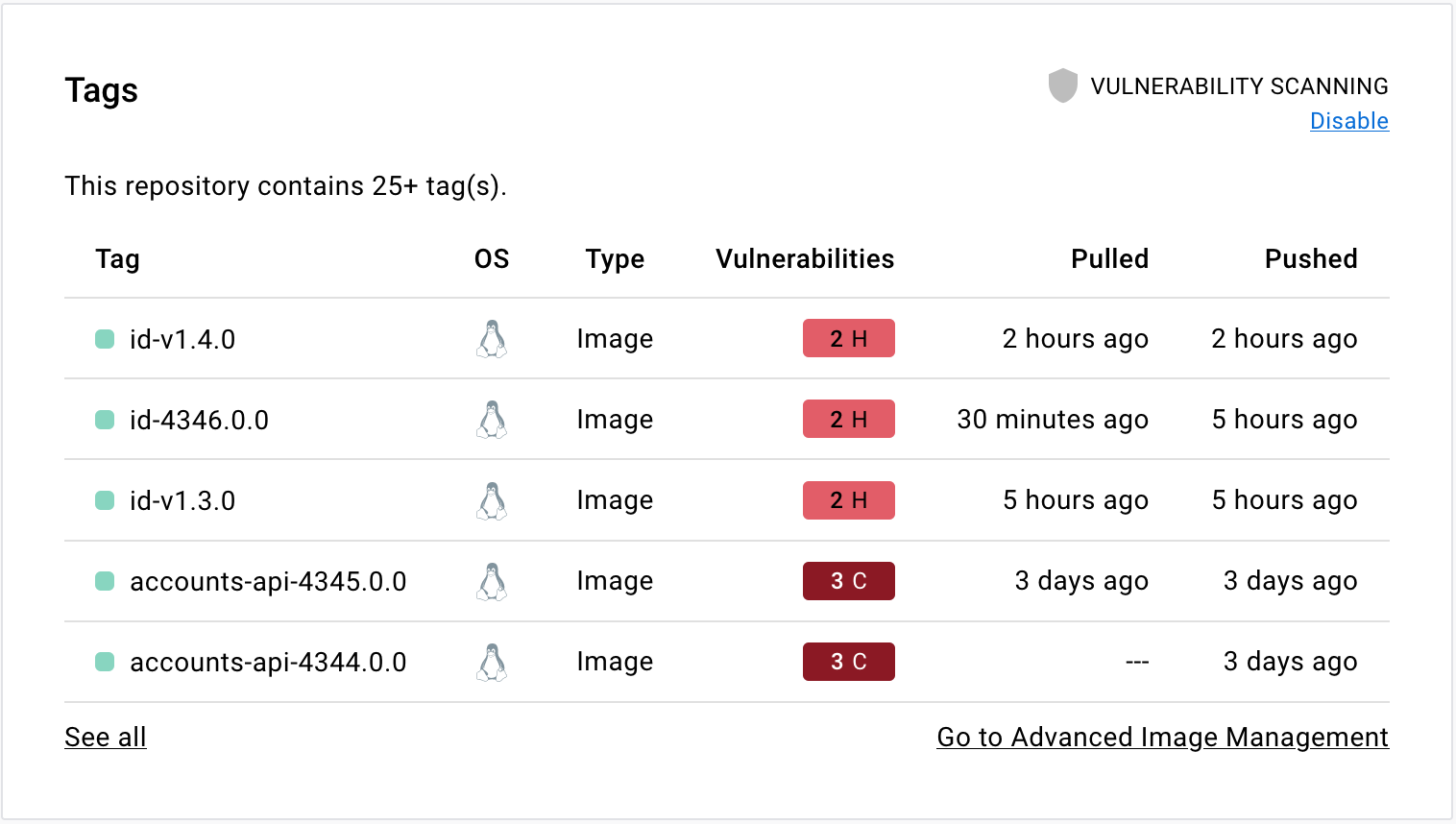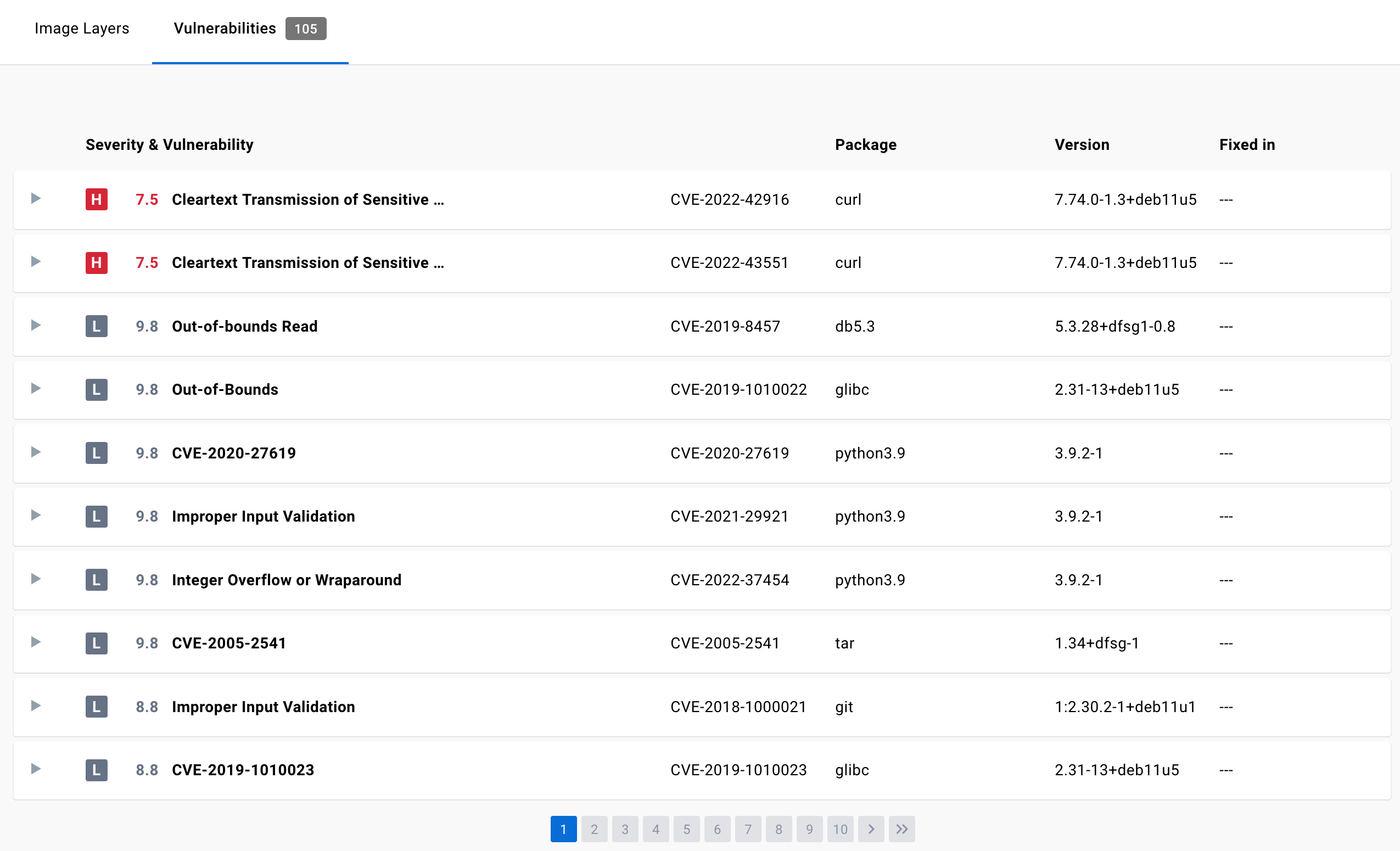[!NOTE]
This page describes the legacy static vulnerability scanning feature of Docker Hub. There's also Docker Scout, which provides more detailed and always up-to-date results, guided remediation steps for improving your security posture, and more.
Docker Hub static scanning requires a Docker Pro, Team, or Business subscription.
Docker Hub static vulnerability scanning lets you automatically run a point-in-time scan on your Docker images for vulnerabilities.
When you push an image to a Docker Hub repository after turning on static scanning, Docker Hub automatically scans the image to identify vulnerabilities. The scan results shows the security state of your images at the time when the scan was run.
Scan results include:
- The source of the vulnerability, such as Operating System (OS) packages and libraries
- The version in which it was introduced
- A recommended fixed version, if available, to remediate the vulnerabilities discovered.
Changes to static scanning in Docker Hub#
From February 27th, 2023, Docker changed the technology that supports the Docker Hub static scanning feature. The static scanning is now powered natively by Docker, instead of a third-party.
As a result of this change, scanning now detects vulnerabilities at a more granular level than before. This in turn means that vulnerability reports may show a higher number of vulnerabilities. If you used vulnerability scanning before February 27th, 2023, you may see that new vulnerability reports list a higher number of vulnerabilities, due to a more thorough analysis.
There is no action required on your part. Scans continue to run as usual with no interruption or changes to pricing. Historical data continues to be available.
Scan images with static vulnerability scanning#
Repository owners and administrators of a Docker Pro, Team, or a Business tier enable and disable static vulnerability scanning. When scanning is active on a repository, anyone with push access can trigger a scan by pushing an image to Docker Hub.
Additionally, repository owners in a Docker Pro subscription and team members in a Team, or a Business subscription can view the detailed scan reports.
[!NOTE]
Static vulnerability scanning supports scanning images which are of AMD64 architecture, Linux OS, and are less than 10 GB in size.
Turn on static vulnerability scanning#
Repository owners and administrators can enable static vulnerability scanning on a repository. If you are a member of a Team or a Business subscription, ensure the repository you would like to enable scanning on is part of the Team or a Business tier.
To enable static vulnerability scanning:
- Sign in to your Docker Hub account.
- Select Repositories and then choose a repository.
- Go to the Settings tab.
- Under Image security insight settings, select Static scanning.
- Select Save.
Scan an image#
To scan an image for vulnerabilities, push the image to Docker Hub, to the repository for which you have turned on scanning:
- Ensure you have installed Docker locally. See Get Docker to download and install Docker on your local machine.
- Use the command line to log into your Docker account. See
docker loginfor more information. - Tag the image to scan. For example, to tag a Redis image, run:
console
$ docker tag redis <your-Docker-ID>/<your-repo-name>:latest
- Push the image to Docker Hub to trigger a static vulnerability scan for the image:
console
$ docker push <your-Docker-ID>/<your-repo-name>:latest
View the vulnerability report#
To view the vulnerability report:
- Go to Docker Hub and open the repository page to view a summary of the static vulnerability scanning report.
It may take a couple of minutes for the vulnerability report to appear in your repository.

- Select the Tags tab, then Digest, then Vulnerabilities to view the detailed scan report.
The scan report displays vulnerabilities identified by the scan, sorting them according to their severity, with highest severity listed at the top. It displays information about the package that contains the vulnerability, the version in which it was introduced, and whether the vulnerability is fixed in a later version.

For more information on this view, see Image details view.
Inspect vulnerabilities#
The vulnerability report sorts vulnerabilities based on their severity. It displays information about the package that contains the vulnerability, the version in which it was introduced, and whether the vulnerability has been fixed in a later version.
The vulnerability scan report also allows development teams and security leads to compare the vulnerability counts across tags to see whether the vulnerabilities are decreasing or increasing over time.
Fix vulnerabilities#
Once a list of vulnerabilities have been identified, there are a couple of actions you can take to remediate the vulnerabilities. For example, you can:
- Specify an updated base image in the Dockerfile, check your application-level dependencies, rebuild the Docker image, and then push the new image to Docker Hub.
- Rebuild the Docker image, run an update command on the OS packages, and push a newer version of image to Docker Hub.
- Edit the Dockerfile to manually remove or update specific libraries that contain vulnerabilities, rebuild the image, and push the new image to Docker Hub
Docker Scout can provide you with concrete and contextual remediation steps for improving image security. For more information, see Docker Scout.
Turn off static vulnerability scanning#
Repository owners and administrators can disable static vulnerability scanning on a repository. To disable scanning:
- Sign in to your Docker Hub account.
- Go to Repositories and then select a repository from the list.
- Go to the Settings tab.
- Under Image security insight settings, select None.
- Select Save.